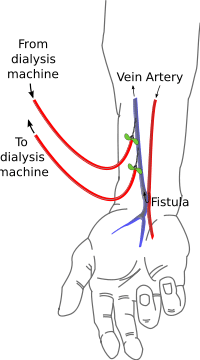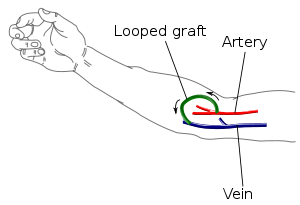TREATED CONDITIONS
Dialysis Access
Fistula Creation – Renal Dialysis
Fistula Creation – Renal Dialysis access allows your doctor to administer medication directly into your blood vessels without repeatedly puncturing your blood vessels.
AV (arteriovenous) fistulas are recognized as the preferred vascular access method. To create a fistula, a vascular surgeon joins an artery and a vein together through anastomosis. Since this bypasses the capillaries, blood flows rapidly through the fistula.
Fistulas are usually created in the nondominant arm and may be situated, the forearm (usually a radiocephalic fistula, in which the radial artery is anastomosed to the cephalic vein), or the elbow (usually a brachiocephalic fistula, where the brachial artery is anastomosed to the cephalic vein). A fistula will take a number of weeks to mature, on average perhaps 4–6 weeks. During treatment, two needles are inserted into the fistula, one to draw blood and one to return it.
The advantages of the AV fistula use are lower infection rates, because no foreign material is involved in their formation, higher blood flow rates (which translates to more effective dialysis), and a lower incidence of thrombosis. The complications are few, but if a fistula has a very high blood flow and the vasculature that supplies the rest of the limb is poor, a steal syndrome can occur, where blood entering the limb is drawn into the fistula and returned to the general circulation without entering the limb’s capillaries. This results in cold extremities of that limb, cramping pains, and, if severe, tissue damage. One long-term complication of an AV fistula can be the development of an aneurysm, a bulging in the wall of the vein where it is weakened by the repeated insertion of needles over time. To a large extent the risk of developing an aneurysm can be reduced by careful needling technique.
If there is no vein or poor quality vein then a prosthetic AV (arteriovenous) grafts can be used.

